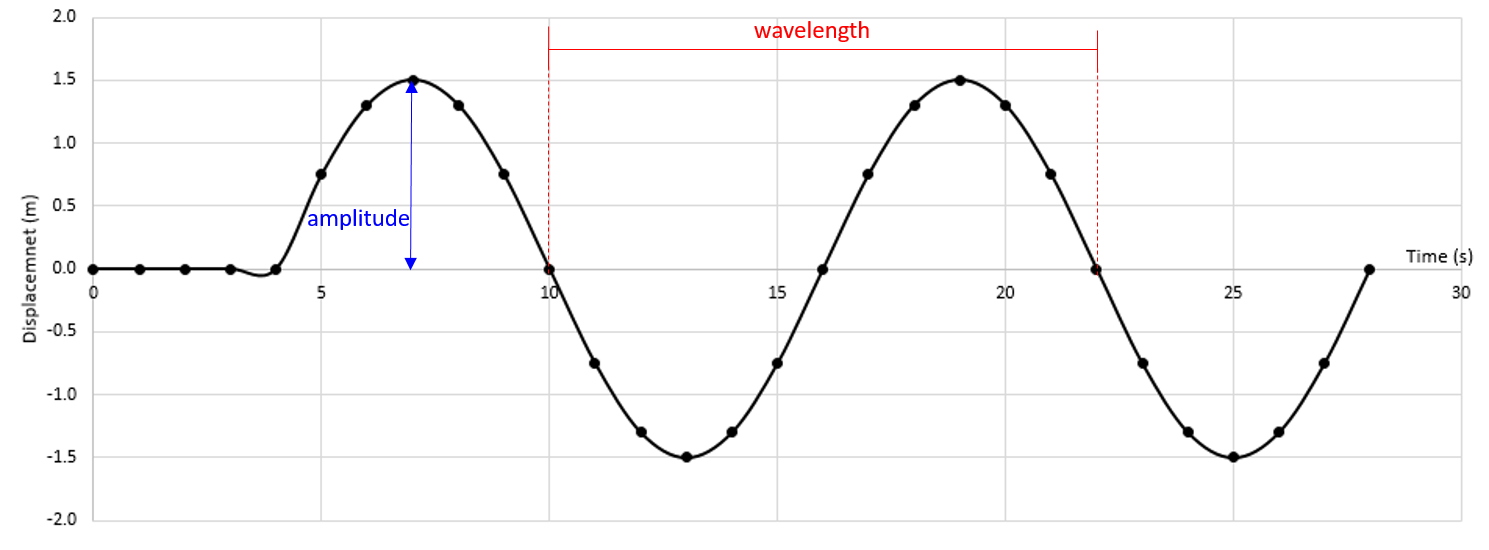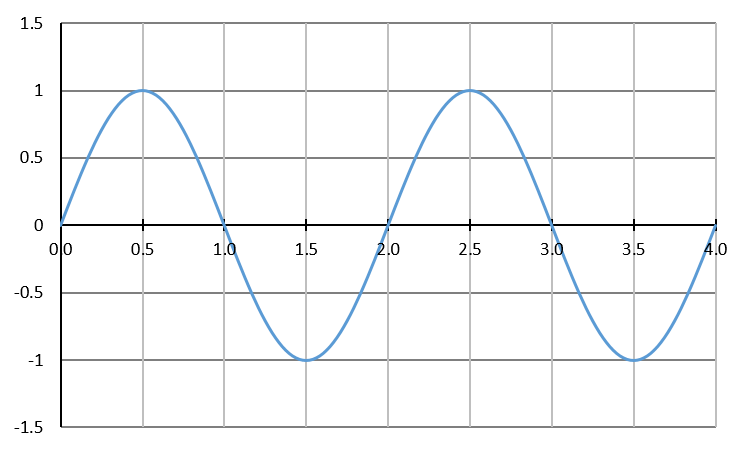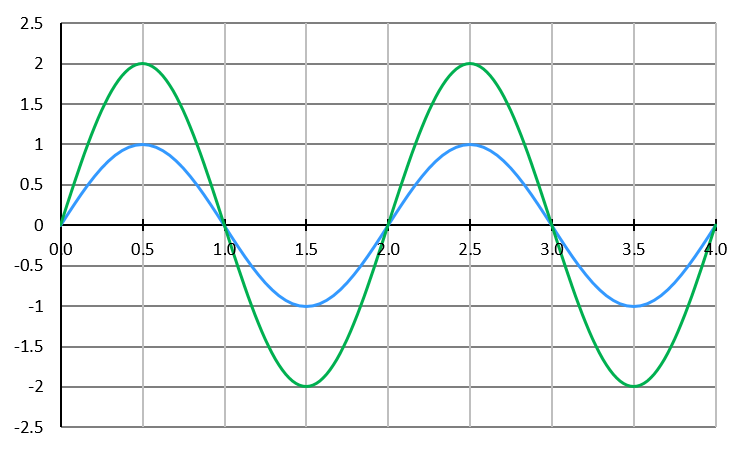Waves, sound and light: Identify, describe and apply principles of waves
Unit 2: Types of waves
Linda Pretorius
Unit outcomes
By the end of this unit you will be able to:
- Distinguish between the two categories of waves, namely longitudinal and transverse.
- Identify examples of longitudinal and transverse waves.
- Identify particle position on graphs showing displacement to illustrate the difference between longitudinal and transverse waves.
- Draw, label and interpret a displacement-position graph of a simple harmonic wave showing wavelength and amplitude.
What you should know
Before you start this unit, make sure you can:
- Describe the nature of a wave, as covered in Subject outcome 3.1, Unit 1.
- Describe the properties of a wave, especially the concepts period, frequency and amplitude, as covered in Subject outcome 3.1, Unit 1.
Introduction
In this unit[1] you will learn about the difference between two types of waves, namely transverse and longitudinal waves. You will apply your knowledge about general wave properties to draw and interpret graphical representations of these waves.
Different types of wave motion
You already know that a is defined as a periodic, continuous disturbance that consists of a train of pulses. From your observations in the activities in Unit 1, you will recall that a wave requires a medium in which to propagate. However, the wave motion is caused by energy travelling through the medium, not the particles of the medium themselves. So at any one position along the wave’s path, the medium merely experiences a momentary disturbance from its original position.
We can describe the type of wave motion by considering the direction of the disturbance of the medium relative to the direction in which the wave travels. This is the fundamental difference between the two types of wave motion, namely transverse and longitudinal.
Transverse waves
In Activity 1.2 in Unit 1, you learnt about the general properties of wave motion by observing how a wave propagates along a rope that was fixed at one end while being flicked up and down at the free end. The resulting wave form is described as a , because the disturbance of the medium was to the direction in which the wave propagated. In other words, the displacement of the medium was in a vertical direction, but the wave travelled in a horizontal direction. Waves that form in water, like in a dam or in the ocean, are examples of transverse waves.
A transverse wave is a wave in which the movement of the particles of the medium is perpendicular to the direction of propagation of the wave.
Properties of a transverse wave
To understand wave behaviour, it is useful to revise the properties of waves. You can do this by, observing a transverse wave.
Activity 2.1: Observe a transverse wave
Time required: 10 minutes
What you need:
- an internet connection
- a phone with a QR scanner
- a notebook and a pencil
What to do:
- Watch the video called Transverse wave (Duration: 00.09). Notice the three coloured ribbons on the string that represent three different particles in the medium.

- Sketch the wave form seen in the video in your notebook.
- Describe the motion of one of the particles (coloured ribbons) over the course of the motion.
- Now watch the video again, but play it frame by frame from time stamp 00.03.
- Pause the video after 10 frames. Compare the displacement of the three particles from the rest position at this time.
- Play a few more frames and then pause the video again. Describe how each particle’s displacement has changed from before.
- At this point, also compare one particle’s displacement to that of the other two.
- Keep playing the video frame by frame, but focus only on the displacement of the blue ribbon (in the middle). Describe its displacement over the course of approximately 30 frames.
Note
You can watch the video frame by frame in Windows Media Player by holding down the Ctrl key and then pressing the ‘play’ button repeatedly.
What did you find?
- The video shows that the particles are displaced in a vertical direction, while the wave moves in a horizontal direction. In other words, the displacement of the medium is perpendicular to the direction in which the wave travels. This is a transverse wave, and the sketch in your notebook should look similar to this diagram.

- If we consider this sketch to represent the motion of a single particle over time, it illustrates the following properties of a transverse wave.
- A: The rest position is the position where the particles of a medium would be if there was no disturbance.
- B: The crest is the highest point of displacement above the rest position.
- C: The trough is the lowest point of displacement below the rest position, and is equal to the height of the crest.
- D: The amplitude is the maximum height of the disturbance from the rest position.
- E: The wavelength is the distance between any two consecutive points on a wave that are in phase.
- When you focused only on the blue ribbon, you would have seen that as the energy reaches a particle (the ribbon) at a specific position along the medium, the particle is displaced above its rest position. It continues in this upward direction until it reaches its maximum displacement above the rest position, and then incrementally starts moving downwards. It continues in this direction downward until it reaches a maximum displacement below the rest position. It then incrementally starts moving upwards again, back to the rest position, and the cycle continues. Although the particle’s vertical position from the rest position changes, its horizontal position remains unchanged.
- You would also have seen that the particles are not all at the same displacement at a fixed time. This is because a different amount of energy has been transferred to them at that specific moment. Particles on either side of the one you are focussing on will be less displaced because the energy of the wave has either moved past the earlier particle already or is yet to reach the particle further along the medium.
- This pattern of displacement continues as long as the wave propagates along the medium.
Note
Refer back to Unit 1 to revise these properties of wave motion.
To visualise a particle’s position over time in a transverse wave, we can plot displacement against time on a graph. Watch this animation to see how a graph of transverse wave motion develops.
Run through the animation once at normal speed, and then run it stepwise using the ‘forward step’ button to see how the displacement time graph develops.
Example 2.1
- Use the data in the table to draw a graph that shows how a single particle’s position changes in a transverse wave as the wave moves through the medium.
Remember: The particle does not move horizontally.

- Indicate the wavelength on the graph.
- Indicate the wave’s amplitude on the graph.
- Does the graph represent a particle at the start of the wave motion or one some distance from the starting position? Give the reason for your answer.
- Describe the displacement of a particle that is half a wavelength to the right of the particle represented by this graph. Explain your reasoning.
Solutions
- – 3. The wave form is shown below. The wavelength is shown in red. The amplitude is shown in blue.

- The graph shows no displacement of particles for some time. This shows that the energy reached the particle only after some time, which means that the particle was some distance away from the start of the wave motion.
- A particle that is half a wavelength to the right of the particle presented by this graph will be displaced later. That means its wave form will be shifted half a wavelength to the right.
Longitudinal waves
When we studied transverse waves, we looked at two different motions: the motion of the particles of the medium and the motion of the wave itself. We can follow the same approach to illustrate the properties of a longitudinal waves.
In a , the particles of the medium move parallel to the motion of the wave – in other words, in the same direction as which the wave travels. An example of a longitudinal wave is a sound wave. It is difficult to observe a sound wave visually, though. A slinky spring is useful in illustrating the properties of a longitudinal wave, as you will see in Activity 2.2.
A longitudinal wave is a wave in which the movement of the particles of the medium is parallel to the direction of propagation of the wave.
Activity 2.2: Investigate longitudinal waves
Time required: 10 minutes
What you need:
- a slinky spring
- a notebook and a pencil
What to do:
- Take a slinky spring and lay it on a flat surface.
- Hold one end and pull the free end of the spring and push it away from you and then pull it back towards you. Observe what happens.
- Now tie a ribbon to one coil in the middle of the spring.
- Pull the free end of the spring back and forth again and observe the motion of the ribbon.
- Then pull the spring back and forth continuously to set up a train of pulses (in other words, a wave). In your notebook, draw the motion of the wave.
What did you find?
- When you pulled the slinky spring backwards and forwards, the disturbance of the individual coils occurred in the same direction as the direction of the pulling motion.
- The ribbon represented a particle of the medium. From the demonstration, you could see that the particles of the medium move in the same plane as the wave (the direction of the energy) in a longitudinal wave.
- The wave motion you observed should look similar to the diagram shown here. The diagram shows that, as the energy travels through the medium, the particles of the medium are squeezed together in some areas and spread out in other areas. This forms a periodic pattern.

Properties of a longitudinal wave
Activity 2.2 demonstrated that the properties of a longitudinal wave are similar to a transverse wave; a longitudinal wave also involves a repeating pattern of the medium being displaced from its rest position. However, instead of the medium being displaced vertically above or below the rest position, the particles of the medium are squeezed closer together or spread out further apart along the plane of the rest position in a longitudinal wave.
A region in a longitudinal wave where the particles of the medium are squeezed together is called a compression.
A region in a longitudinal wave where the particles of the medium are spread out is called a rarefaction.

Other properties defined for transverse waves, such as wavelength, amplitude, period and frequency, also apply to longitudinal waves. The wavelength of a longitudinal wave is the distance between two consecutive compressions, or two consecutive rarefactions.
Note
Watch this simulation to see how the position of a particle changes in a longitudinal wave over time.

Summary
In this unit you have learnt the following:
- We can distinguish between two types of waves, namely transverse and longitudinal, based on the direction of the disturbance of the medium relative to the direction in which the wave travels.
- In a transverse wave the movement of the particles of the medium is perpendicular to the direction of propagation of the wave.
- In a longitudinal wave the movement of the particles of the medium is parallel to the direction of propagation of the wave.
- Amplitude is the maximum displacement of a particle from its rest position.
- In a transverse wave, the wavelength is the distance between any two consecutive points in phase, such as two peaks or two troughs.
- In a longitudinal wave, the wavelength is the distance between two consecutive compressions, or two consecutive rarefactions.
Unit 2: Assessment
Suggested time to complete: 15 minutes
- Which of the following is not a longitudinal wave?
- light
- sound
- ultrasound
- In which of the following can a longitudinal wave, such as sound, not travel?
- a solid
- a liquid
- gas
- a vacuum
- You are given the transverse wave below:

.
Draw the following:- A wave with twice the amplitude of the given wave.
- A wave with half the wavelength of the given wave.
The full solutions are at the end of the unit.
Unit 2: Solutions
Unit 2: Assessment
- A: light
- D: vacuum
- .
- The graph of the original wave is shown in blue. The graph of the wave with twice the amplitude is shown in green.

- The graph of the original wave is shown in blue. The graph of the wave with half the wavelength is shown in red.

- The graph of the original wave is shown in blue. The graph of the wave with twice the amplitude is shown in green.
Media Attributions
- QR_Code_PSL2SO31U2_1
- Img01_Transverse wave © DHET is licensed under a CC BY (Attribution) license
- QR_Code_PSL2SO31U2_2
- QR_Code_PSL2SO31U2_4
- Img04_Example2.1 © DHET is licensed under a CC BY (Attribution) license
- Img02_Longitudinal wave © Siyavula is licensed under a CC BY (Attribution) license
- Img03_CompressionRarefaction © DHET is licensed under a CC BY (Attribution) license
- QR_Code_PSL2SO31U2_3
- Img05_Assmnt_Q3 © DHET is licensed under a CC BY (Attribution) license
- Img06_Assessment_Q3a_answer © DHET is licensed under a CC BY (Attribution) license
- Img07_Assessment_Q3b_answer © DHET is licensed under a CC BY (Attribution) license
a periodic, continuous disturbance of a medium and which consists of a train of pulses
a wave in which the movement of the particles of the medium is perpendicular to the direction of propagation of the wave
at a right angle
a wave in which the movement of the particles of the medium is parallel to the direction of propagation of the wave

